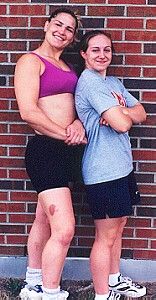
Christine Nordhagen (left) with Canadian Junior wrestler Melissa Kindratsky
Copyright © EJMAS 2001. All rights reserved.
Christine Nordhagen is a five-time world wrestling champion (1994, 1996, 1997, 1998, and 2000), and the winner of six consecutive Canadian Senior championships. She was Canadaís Female Wrestler of the Year from 1993 to 1998, and FILAís International Female Wrestler of the Year in 1997.
In college, she wrestled for the University of Calgary club under Mitch Ostberg and Leigh Vierling. Aged 29, she is fromValhalla Centre, Alberta, and is currently employed as a high school teacher of mathematics, physical education, and dance.

Christine Nordhagen (left) with Canadian Junior wrestler Melissa Kindratsky
|
Start with the bar at the knees. The lifter is Christine Nordhagen.
Shoot the hips underneath to clean the weight up to the shoulders.
Donít use the arms; keep them relaxed and straight. Instead, concentrate
on popping the hips. Keep the back straight and the head up at all times,
even when preparing to lift the bar to the knees.
|
|
Keep the toes pointed slightly out and make sure the back stays straight. Use the legs, not the back, to lift. Keep the elbows pointed forward to help stabilize the lift. The lifter is Melissa Kindratsky.
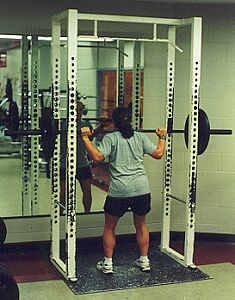 |
|
In all exercises, itís important to use a spotter, but for the bench press itís vital as people have died dropping bars on their necks. Use slow controlled movements for the exercise and move the bar all the way down to the chest. Donít bounce the weight back up.
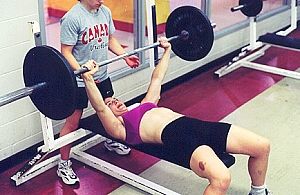 |
|
For chin-ups, go from a full arm extension to the chin over the bar. Donít let your body rock, but keep it steady at all times. The key is a controlled pull.
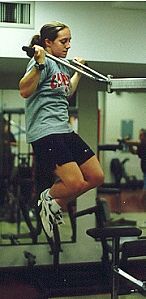 |
|
Get up the rope as quickly and explosively as you can. For extra credit, donít use the feet.
|
Physio Ball
This is a relatively new exercise method developed to work the core body stabilizers. Using it will help prevent injury and also improve other lifts by allowing you to maintain a more stable body position.
For the abdominal muscles:
| Sit-ups.
Start with the feet flat on the floor and your back stretched completely over the ball.
With control, keeping the back straight and using only the abdominal muscles, sit fully upright.
Notice how the upper legs and the torso muscles control the ball. |
| Crunches.
Start with the upper back on the ball.
Now pull your upper body as far forward as possible.
Note how the ball maintains the crunch. No cheating is allowed (or possible). |
| V-sits.
You donít have to sit on the ball all the time. For example, in this exercise you pass the ball from your hands to your feet while keeping the arms and legs straight.
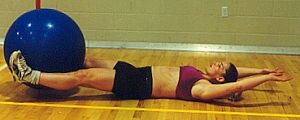 |
| Bridges.
By putting your hands on the floor and your shins on the ball, you can set up a series of exercises that work just about every muscle in your body all at once.
Roll the ball forward with your feet while you tuck your knees to your chest.
Roll the ball forward keeping the legs straight.
Maintaining the bridge using muscles all down the front of your body, and controlling the ball using your shoulders, lift one leg, then the other. This exercises the upper thighs, butt, and lower back.
|
Arms and shoulders
| If youíre still going, try some push-ups.
Donít forget to try different hand positions. Work angles so that the stabilizers have to work to control the ball.
|
Trunk twists and warm-down
| Lie on the ball and roll side-to-side as you stretch and twist the
back.
Or sit on it and rock the hips back and forth. |
For Further Reading
Stubbs, Dave. "Wrestling Old Prejudices," Montreal Gazette, January 18, 2000, http://www.caaws.ca/Whats_New/jan00/wrestl_jan18.htm
Taylor, Kim. "Wrestling: Melissa Kindratsky, Canadian Collegiate Wrestler," http://ejmas.com/jalt/jaltart_taylor_0201.htm
Wrestling Canada. "National Team Members: Christine Nordhagen, 68 Kg. http://www.wrestling.ca/bios/nordhagen.html